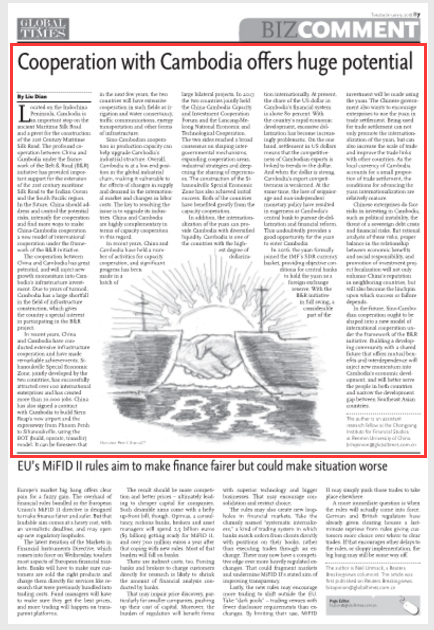Major Power Relations
Your Present Location: PROGRAMS> Major Power RelationsLiu Dian: Cooperation with Cambodia offers huge potential
By Liu Dian Source: Global Times Published: 2018-1-8
Located on the Indochina Peninsula, Cambodia is an important stop on the ancient Maritime Silk Road and a pivot for the construction of the 21st Century Maritime Silk Road. The profound cooperation between China and Cambodia under the framework of the Belt & Road (B&R) initiative has provided important support for the extension of the 21st Century Maritime Silk Road to the Indian Ocean and the South Pacific region. In the future, China should address and control the potential risks, intensify the cooperation and find more ways to make China-Cambodia cooperation a new model of international cooperation under the framework of the B&R initiative.
The cooperation between China and Cambodia has great potential, and will inject new growth momentum into Cambodia`s infrastructure investment. Due to years of turmoil, Cambodia has a large shortfall in the field of infrastructure construction, which gives the country a special interest in participating in the B&R project.

In recent years, China and Cambodia have conducted extensive infrastructure cooperation and have made remarkable achievements. Sihanoukville Special Economic Zone, jointly developed by the two countries, has successfully attracted over 100 international enterprises and has created more than 10,000 jobs. China has also signed a contract with Cambodia to build Siem Reap`s new airport and the expressway from Phnom Penh to Sihanoukville, using the BOT (build, operate, transfer) model. It can be foreseen that in the next few years, the two countries will have extensive cooperation in such fields as irrigation and water conservancy, traffic communications, energy transportation and other forms of infrastructure.
Sino-Cambodian cooperation in production capacity can help upgrade Cambodia`s industrial structure. Overall, Cambodia is at a low-end position in the global industrial chain, making it vulnerable to the effects of changes in supply and demand in the international market and changes in labor costs. The key to resolving the issue is to upgrade its industries. China and Cambodia are highly complementary in terms of capacity cooperation in this regard.
In recent years, China and Cambodia have held a number of activities for capacity cooperation, and significant progress has been made in a batch of large bilateral projects. In 2017, the two countries jointly held the China-Cambodia Capacity and Investment Cooperation Forum and the Lancang-Mekong National Economic and Technological Cooperation. The two sides reached a broad consensus on shaping intergovernmental mechanisms, expanding cooperation areas, industrial strategies and deepening the sharing of experiences. The construction of the Sihanoukville Special Economic Zone has also achieved initial success. Both of the countries have benefited greatly from the capacity cooperation.
In addition, the internationalization of the yuan can provide Cambodia with diversified liquidity. Cambodia is one of the countries with the highest degree of dollarization internationally. At present, the share of the US dollar in Cambodia`s financial system is above 80 percent. With the country`s rapid economic development, excessive dollarization has become increasingly problematic. On the one hand, settlement in US dollars means that the competitiveness of Cambodian exports is linked to trends in the dollar. And when the dollar is strong, Cambodia`s export competitiveness is weakened. At the same time, the loss of seigniorage and non-independent monetary policy have resulted in eagerness at Cambodia`s central bank to pursue de-dollarization and financial reform. This undoubtedly provides a good opportunity for the yuan to enter Cambodia.
In 2016, the yuan formally joined the IMF`s SDR currency basket, providing objective conditions for central banks to hold the yuan as a foreign exchange reserve. With the B&R initiative in full swing, a considerable part of the investment will be made using the yuan. The Chinese government also wants to encourage enterprises to use the yuan in trade settlement. Being used for trade settlement can not only promote the internationalization of the yuan, but can also increase the scale of trade and improve the trade links with other countries. As the local currency of Cambodia accounts for a small proportion of trade settlement, the conditions for advancing the yuan internationalization are relatively mature.
Chinese enterprises do face risks in investing in Cambodia, such as political instability, the threat of a sovereign debt crisis and financial risks. But rational analysis of these risks, proper balance in the relationship between economic benefits and social responsibility, and promotion of investment project localization will not only enhance China`s reputation in neighboring countries, but will also become the linchpin upon which success or failure depends.
In the future, Sino-Cambodian cooperation ought to be shaped into a new model of international cooperation under the framework of the B&R initiative. Building a developing community with a shared future that offers mutual benefits and interdependence will inject new momentum into Cambodia`s economic development, and will better serve the people in both countries and narrow the development gap between Southeast Asian countries.
The author is an assistant research fellow at the Chongyang Institute for Financial Studies at Renmin University of China.
Key Words: Cambodia; Belt and Road; China; Liu Dian























































































 京公网安备 11010802037854号
京公网安备 11010802037854号





